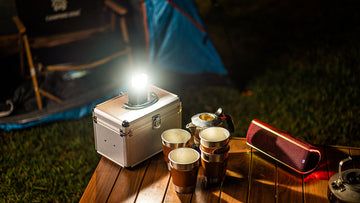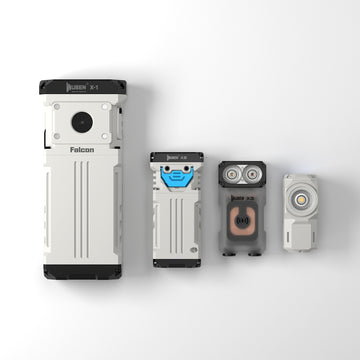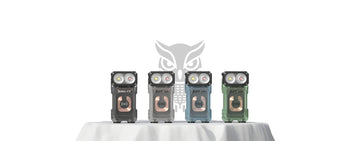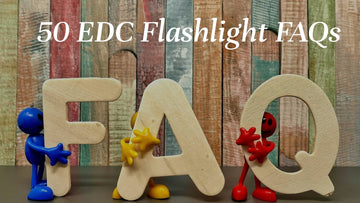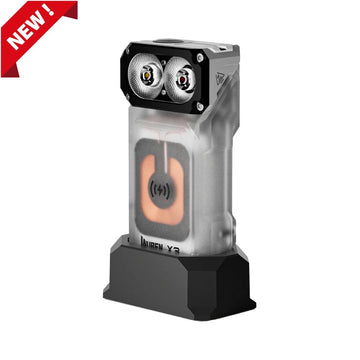
In the realm of flashlights, lumens play a critical role in determining the brightness and overall performance of these portable light sources. To fully comprehend the significance of lumens and their relation to flashlight quality, it is crucial to explore their definition, understand their measurement, and consider various factors that influence the optimal lumen count for different situations. In this article, we will dive into the intricacies of lumens and shed light on how many lumens constitute a good flashlight.
Lumens, in the context of flashlights, refer to the unit of measurement used to quantify the total amount of visible light emitted by the device. It represents the brightness level and determines the effectiveness of a flashlight in illuminating its surroundings. Measured with precision, lumens provide an objective assessment of a flashlight's output, enabling users to make informed decisions based on their specific lighting requirements.
Lumens have a direct correlation with flashlight brightness. The higher the lumen count, the brighter the flashlight's beam. This increased brightness translates into enhanced visibility, wider coverage, and improved effectiveness in various scenarios. A good flashlight should possess a lumen count that adequately meets the user's needs, striking a balance between brightness and practicality.
Several factors should be taken into account when determining the optimal lumen count for a flashlight. By considering these factors, users can choose a flashlight that best suits their specific needs and ensures optimal performance in various situations.
Purpose and Intended Use
The intended purpose of the flashlight plays a crucial role in determining the appropriate lumen count. Different activities require varying levels of brightness. For instance, a compact flashlight with a lower lumen count may be sufficient for everyday tasks such as finding items in a dark room or during power outages. However, outdoor activities like camping or hiking may demand a higher lumen count to illuminate larger areas and navigate through challenging terrains.
Lighting Range and Distance
The desired lighting range and distance also impact the optimal lumen count for a flashlight. If the flashlight's primary purpose is to provide illumination for short-range tasks, such as reading or working on small projects, a lower lumen count may be suitable. On the other hand, activities that require a longer beam distance, such as search and rescue operations or exploring vast areas, would benefit from a flashlight with a higher lumen count to ensure ample coverage and visibility.
Battery Life and Efficiency
Battery life and efficiency are crucial factors to consider when evaluating the optimal lumen count. Flashlights with higher lumen counts generally consume more power, leading to shorter battery life. It is important to strike a balance between desired brightness and battery performance to ensure the flashlight remains functional for extended periods or during emergencies.
Environmental Conditions
Environmental conditions can significantly affect the performance of a flashlight. Factors such as fog, rain, or smoke can diminish visibility and scatter light, necessitating a higher lumen count to overcome these challenges. Understanding the typical environmental conditions in which the flashlight will be used is vital in determining the appropriate lumen count for optimal performance.
While there is no one-size-fits-all answer to how many lumens constitute a good flashlight, some general guidelines can assist in the decision-making process.
General Guidelines
For everyday use and common household tasks, flashlights with lumen counts ranging from 10 to 100 are typically sufficient. They provide adequate brightness for navigating dark spaces, finding objects, or handling power outages. However, for outdoor enthusiasts, emergency responders, or those requiring heightened brightness, flashlights with lumen counts between 100 and 1000 or higher may be more suitable, offering greater coverage and improved visibility.
Specific Applications and Scenarios
Specific applications and scenarios may demand different lumen counts. For example, situations that require extensive coverage in large outdoor areas, such as search and rescue missions or nighttime exploration, may necessitate flashlights with lumen counts surpassing 1000 to effectively illuminate the surroundings. Conversely, compact pocket flashlights used for close-range tasks like reading or finding keys may only require lumen counts in the range of 10 to 50.
In conclusion, determining how many lumens constitute a good flashlight relies on several factors, including the intended purpose, lighting range, battery life, and environmental conditions. By considering these factors, individuals can make informed decisions and select flashlights that offer optimal brightness for their specific needs. Remember to strike a balance between desired brightness, practicality, and battery performance to ensure a flashlight that meets your requirements effectively.
Lumens, in the context of flashlights, refer to the unit of measurement used to quantify the total amount of visible light emitted by the device. It represents the brightness level and determines the effectiveness of a flashlight in illuminating its surroundings. Measured with precision, lumens provide an objective assessment of a flashlight's output, enabling users to make informed decisions based on their specific lighting requirements.
Lumens have a direct correlation with flashlight brightness. The higher the lumen count, the brighter the flashlight's beam. This increased brightness translates into enhanced visibility, wider coverage, and improved effectiveness in various scenarios. A good flashlight should possess a lumen count that adequately meets the user's needs, striking a balance between brightness and practicality.
Several factors should be taken into account when determining the optimal lumen count for a flashlight. By considering these factors, users can choose a flashlight that best suits their specific needs and ensures optimal performance in various situations.
Purpose and Intended Use
The intended purpose of the flashlight plays a crucial role in determining the appropriate lumen count. Different activities require varying levels of brightness. For instance, a compact flashlight with a lower lumen count may be sufficient for everyday tasks such as finding items in a dark room or during power outages. However, outdoor activities like camping or hiking may demand a higher lumen count to illuminate larger areas and navigate through challenging terrains.
Lighting Range and Distance
The desired lighting range and distance also impact the optimal lumen count for a flashlight. If the flashlight's primary purpose is to provide illumination for short-range tasks, such as reading or working on small projects, a lower lumen count may be suitable. On the other hand, activities that require a longer beam distance, such as search and rescue operations or exploring vast areas, would benefit from a flashlight with a higher lumen count to ensure ample coverage and visibility.
Battery Life and Efficiency
Battery life and efficiency are crucial factors to consider when evaluating the optimal lumen count. Flashlights with higher lumen counts generally consume more power, leading to shorter battery life. It is important to strike a balance between desired brightness and battery performance to ensure the flashlight remains functional for extended periods or during emergencies.
Environmental Conditions
Environmental conditions can significantly affect the performance of a flashlight. Factors such as fog, rain, or smoke can diminish visibility and scatter light, necessitating a higher lumen count to overcome these challenges. Understanding the typical environmental conditions in which the flashlight will be used is vital in determining the appropriate lumen count for optimal performance.
While there is no one-size-fits-all answer to how many lumens constitute a good flashlight, some general guidelines can assist in the decision-making process.
General Guidelines
For everyday use and common household tasks, flashlights with lumen counts ranging from 10 to 100 are typically sufficient. They provide adequate brightness for navigating dark spaces, finding objects, or handling power outages. However, for outdoor enthusiasts, emergency responders, or those requiring heightened brightness, flashlights with lumen counts between 100 and 1000 or higher may be more suitable, offering greater coverage and improved visibility.
Specific Applications and Scenarios
Specific applications and scenarios may demand different lumen counts. For example, situations that require extensive coverage in large outdoor areas, such as search and rescue missions or nighttime exploration, may necessitate flashlights with lumen counts surpassing 1000 to effectively illuminate the surroundings. Conversely, compact pocket flashlights used for close-range tasks like reading or finding keys may only require lumen counts in the range of 10 to 50.
In conclusion, determining how many lumens constitute a good flashlight relies on several factors, including the intended purpose, lighting range, battery life, and environmental conditions. By considering these factors, individuals can make informed decisions and select flashlights that offer optimal brightness for their specific needs. Remember to strike a balance between desired brightness, practicality, and battery performance to ensure a flashlight that meets your requirements effectively.
Tags:
Related Articles

